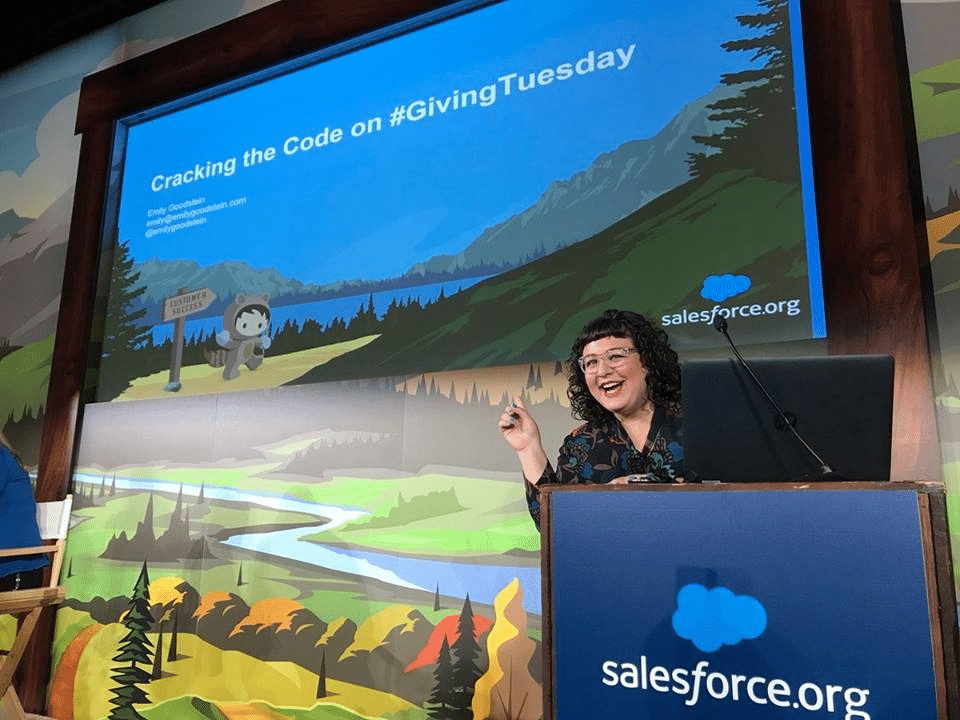Q & A between SEED SPOT and Emily Goodstein, Online Fundraising Strategist
By Bianca Buliga, Digital Marketing Manager
We recently had the opportunity to sit down with Emily Goodstein, a fundraising strategist, author, and advocate. She gave us the opportunity to pick her brain on all things #GivingTuesday. We’re excited to share her thoughts, insights, and best practices!
SEED SPOT: Tell us about yourself! How did you gain your fundraising expertise?
Emily: I’m a lifelong resident of the District of Columbia, digital marketer and online fundraising enthusiast. I’ve spent over 15 years working at or with nonprofits. My work usually involves helping purpose driven organizations tell their stories in effective ways to gain new supporters. Before starting my own digital marketing practice, I worked at Convio and Blackbaud. These gigs were great for many reasons — mainly because I had a front row seat while good-for-the-world groups put together strategies and campaigns to raise as much money from their donors. Most of my clients use email, web and social media tactics to creatively engage supporters. As a consultant, I work with 12 organizations doing much of the same work.

Emily Goodstein, Fundraiser Extraordinaire!
SEED SPOT: What are common misperceptions about #GivingTuesday that you’d like to debunk?
EG: Oh, there are so many.
One of my favorites is that #GivingTuesday is only about giving money — but it is really about all kinds of giving. Many organizations break from fundraising asks on #GivingTuesday and ask for donations of time or items they need. Other organizations use the day to simply say thank you in the midst of a sometimes overwhelming end of year season.
Another myth about #GivingTuesday it is just one day — when in reality in could actually kick off an organization’s entire end of year fundraising cycle. And taking this one step further, prep for #GivingTuesday should really begin the day after last year’s GT ended — thanking your donors and thinking about what worked and what didn’t.

Emily presenting at Salesforce.org’s conference on how to create an effective #GivingTuesday campaign
SEED SPOT: How can entrepreneurs leverage #GivingTuesday as a springboard into a lucrative year-round giving campaign?
EG: I love this question! The truth is, a good #GivingTuesday strategy is actually just a good year-round fundraising strategy. So starting in January, folks may consider some list growth tactics that can take place all year long (so when GT hits, they have a whole bunch of eager fans waiting to hear from them). Consider a pop-up on your website to gather email addresses or running a contest where folks can enter by giving their email. And spend the year cultivating donors and building a relationship with them — showcasing how you and your cause add value to their lives or their communities. So, that way, when you get around to asking for money in November and December, folks know how important your organization is and don’t feel like the ask comes out of the blue.
The other great thing that should happen year-round is reaching donors on many channels — not just by email. So once you get the email address of a supporter, consider re-targeting them on Facebook via the Custom Audience feature or sending a strategic direct mail piece. Or giving them a ring to thank them for their involvement without a fundraising ask (SEED SPOT note: this is a great way to engage your Board Members! Imagine getting a thank you call from an organization’s Board!) All this work will mean that your donation pitches are better received and donors already feel connected to your cause before they are asked to support it.
Lastly, remember to spend non-peak fundraising months testing what works well. You can always do an A/B test of email subject lines or use the Facebook promotion feature to test messages or imagery with a small budget. This way, when November and December roll around, you will know what will resonate with your audience to gain the highest donation response rate possible.
SEED SPOT: What are some common mistakes entrepreneurs make in nurturing donor relationships and how can these be avoided?
EG: The biggest mistakes I see time and time again are organizations thinking #GivingTuesday is a super saturated time and they don’t plan to participate because the field is so crowded. The kicker here is that we see the number of dollars raised growing year over year (over $300 million was raised online in 2017, up 78% from 2016), so if organizations choose not to participate in #GivingTuesday, they’re actually leaving money on the table. For organizations who aren’t in need of fundraising dollars (or, like some of my clients, organizations who had other reasons to fundraise only a month or so before #GivingTuesday hits), it may be a time to ask for non monetary gifts — but it is a time when your community is expecting to hear from you — even if your message is purely one of thanks.
The other common mistake, which can be easily avoided, is entrepreneurs only communicating with supporters in a sometimes stuffy newsletter format. Don’t wait until you have seven or eight things to list in a newsletter — it is okay to send more emails with only one ask per message as opposed to packaging everything up into a periodic update. Additionally, feeling forced to produce content just because it is “time to send out the next newsletter” is a really easy mistake to make. But cut yourself some slack and email your list when you have something to tell them, not because the calendar says it is time to send an update.
SEED SPOT: Any additional resources entrepreneurs can look into for more help?
EG: I love this guide from Salesforce.org — check it out and get inspired as you gear up for #GivingTuesday.
The team at the Nonprofit Technology Network has some amazing resources too: https://www.nten.org/
A huge thank you to Emily for helping us give power to our #GivingTuesday strategy! We’re excited to take her advice to amplify our own #GivingTuesday campaign. Learn how you can donate to SEED SPOT here.




